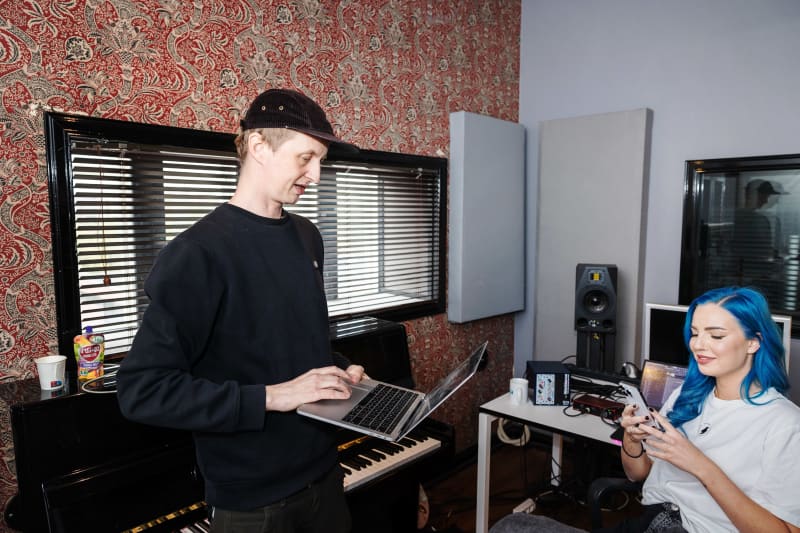A new study highlights the conflict between music consumption and creators’ remuneration. Songwriters still live on radio plays, even though music is listened to on streaming services.
– Let’s try a little faster.
The song may become a hit or no one will ever hear it. Salokorpi uses all his expertise to ensure that the demo he is making now ends up on a record, in the best case, as a single. He receives compensation for his work only if the song is published and listened to. Salokorpi lives on royalties, he doesn’t get paid for a studio day.

\”Less than a million listens equals nothing\”
Salokorpi has been making songs for different artists for fifteen years. In that time, a few giant hits have been born. Among the biggest are Teflon Brothers’ *Maradona* (2014) and *Pämpää* (2015) and Elastinen’s *Supervoimii* (2018).
Like today, those songs are also available on digital services all over the world, from Spotify to YouTube, from Apple Music to Deezer. In addition, they are still played on radio channels and at the concerts of the artists in question. Such hits are a life hole for music writers doing their work behind the scenes. Even though the songs have been released for years, they still generate income for the creators.
However, from the author’s point of view, it is precisely the radio plays and live gigs that are decisive. With their help, the creators of the song earn their living.
Even giant hits don’t bring huge sums of money to song writers through digital services. For example, *Maradona* has almost 18 million listens on Spotify alone. According to Salokorven, with such an amount, we start talking about four-digit royalties.
– If there are less than a million listens on Spotify, from the point of view of the author of the song, it is the same as nothing. The money from streaming services is a nice little bonus.
Having established himself in his field, Salokorpi has calculated that since 2016, the songs he wrote have been streamed approximately 280 million times. Spotify and other streaming services have billed him a few thousand annually.
– No one lives for it. The fact that some of the hits are still playing on the radio brings some security. You get a base fund from it. On the other hand, I can’t know if I’ll get any radio singles next year. Nothing is certain in this industry.
Nine out of ten Finns stream music
At the same time as music creators live on radio plays and live gigs the old fashioned way, the market has been revolutionized. Cash flows have remained the same, even though the vast majority of music listeners have switched to streaming services. Their popularity only grew during the corona pandemic.
This mismatch between music consumption and creators’ earnings is addressed by a European study on the streaming market published today.
After all, it is mainstream. According to the study, nine out of ten Finns use streaming services to listen to music. The same figure applies to the entire Nordic countries. Streaming services account for 68 percent of global music listening.
At the same time, the range of services has grown significantly. More than 70 million songs are currently available, and there are about eight million artists on Spotify alone.

\”The price of services should be increased\”
Numerous structural flaws emerge in the study. According to it, the value of music in streaming services has continuously decreased. According to the study, there are three reasons for this:
Correspondingly, the corrective measures proposed in the report include raising the prices of services and encouraging consumers to place paid orders.
From the point of view of consumers, therefore, quite unfavorable developments, but on the other hand, the study compares the streaming services of series and movies, where free versions are a rarity these days.
Maybe it’s time for the free trial period to end on the music side as well, says Salokorpi.
– I don’t know if the prices should be raised, but the idea that music should be completely free is difficult for those who make that music, he says.
– From the free version, the revenue for the authors is less than a tenth of that from the paid versions, Härmänmaa reminds.
According to the study, the algorithm-driven, hit-driven market makes the situation even worse for music creators. For example, in Spotify, less than one percent of artists produce 90 percent of monthly streams.
– The competition is really tight and bloody, because the volume is absolutely amazing: about 60,000 new songs become available every day. The new songs compete not only with each other but also with everything previously released, because the back catalogs are equally available, Härmänmaa states.
The author of the song gets about 10 percent
The revenue distribution of streaming services has its own question. According to the study, the income from streaming services is currently distributed in such a way that 30 percent of the price paid by subscribers remains for the service, 55 percent goes to record companies and performers, and only 15 percent to music creators and publishers.
According to Salokorven, after the publisher’s share, the creators of the songs practically get about ten percent of the cake.
– Yes, it seems unfair when turnover in the music industry is at a record level. The percentages also have to be put on the table somehow. If it seems that it is not possible to negotiate otherwise, then at least the authors and publishers of the songs have their rights, Salokorpi reminds.
From the point of view of music creators, a desirable development would therefore be an increase in the subscription prices of streaming services and a decrease in the supply of free versions financed by advertising.

It’s about a living music culture, i.e. new good songs
So what does it matter to the consumer how much music creators earn from their songs?
A lot, say both Teoston Härmänmaa and song writer Salokorpi.
– A living music culture is important, especially when we are talking about small language areas like Finland. Music creators must be able to live with their work in order to create a new music culture, says Härmänmaa.
– If the creators of the music can’t get along with the work they do, in the long run everyone loses. You can’t run the industry without good songs.
The research shows that artists are in almost as difficult a position as music creators when it comes to streaming services. If the songwriter gets about ten percent of the cake, the artist gets about a fifth, depending on the contract with the record company.
– And we are, after all, the primary producers of music. Without us, the songs certainly wouldn’t exist, Salokorpi reminds.

